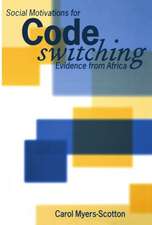Functional Organization of the Plant Nucleus: Plant Cell Monographs, cartea 14
Editat de Iris Meieren Limba Engleză Hardback – 27 noi 2008
| Toate formatele și edițiile | Preț | Express |
|---|---|---|
| Paperback (1) | 777.45 lei 38-44 zile | |
| Springer Berlin, Heidelberg – 23 noi 2010 | 777.45 lei 38-44 zile | |
| Hardback (1) | 948.16 lei 6-8 săpt. | |
| Springer Berlin, Heidelberg – 27 noi 2008 | 948.16 lei 6-8 săpt. |
Din seria Plant Cell Monographs
- 18%
 Preț: 947.04 lei
Preț: 947.04 lei - 24%
 Preț: 797.37 lei
Preț: 797.37 lei - 18%
 Preț: 957.62 lei
Preț: 957.62 lei - 18%
 Preț: 943.88 lei
Preț: 943.88 lei - 24%
 Preț: 790.00 lei
Preț: 790.00 lei - 18%
 Preț: 952.89 lei
Preț: 952.89 lei - 18%
 Preț: 950.84 lei
Preț: 950.84 lei - 18%
 Preț: 1381.43 lei
Preț: 1381.43 lei - 18%
 Preț: 942.63 lei
Preț: 942.63 lei - 18%
 Preț: 1226.73 lei
Preț: 1226.73 lei - 18%
 Preț: 952.89 lei
Preț: 952.89 lei - 18%
 Preț: 943.43 lei
Preț: 943.43 lei - 18%
 Preț: 956.03 lei
Preț: 956.03 lei - 18%
 Preț: 1121.76 lei
Preț: 1121.76 lei - 18%
 Preț: 1386.48 lei
Preț: 1386.48 lei - 15%
 Preț: 634.00 lei
Preț: 634.00 lei - 24%
 Preț: 785.83 lei
Preț: 785.83 lei - 18%
 Preț: 953.20 lei
Preț: 953.20 lei - 18%
 Preț: 952.09 lei
Preț: 952.09 lei - 18%
 Preț: 950.66 lei
Preț: 950.66 lei - 18%
 Preț: 945.30 lei
Preț: 945.30 lei - 18%
 Preț: 948.79 lei
Preț: 948.79 lei - 18%
 Preț: 1231.47 lei
Preț: 1231.47 lei
Preț: 948.16 lei
Preț vechi: 1156.29 lei
-18% Nou
Puncte Express: 1422
Preț estimativ în valută:
181.43€ • 189.94$ • 150.12£
181.43€ • 189.94$ • 150.12£
Carte tipărită la comandă
Livrare economică 07-21 aprilie
Preluare comenzi: 021 569.72.76
Specificații
ISBN-13: 9783540710578
ISBN-10: 3540710574
Pagini: 205
Ilustrații: XII, 192 p. 18 illus., 2 illus. in color.
Dimensiuni: 155 x 235 x 17 mm
Greutate: 0.52 kg
Ediția:2009
Editura: Springer Berlin, Heidelberg
Colecția Springer
Seria Plant Cell Monographs
Locul publicării:Berlin, Heidelberg, Germany
ISBN-10: 3540710574
Pagini: 205
Ilustrații: XII, 192 p. 18 illus., 2 illus. in color.
Dimensiuni: 155 x 235 x 17 mm
Greutate: 0.52 kg
Ediția:2009
Editura: Springer Berlin, Heidelberg
Colecția Springer
Seria Plant Cell Monographs
Locul publicării:Berlin, Heidelberg, Germany
Public țintă
ResearchCuprins
Functional Organization of the Plant Nucleus.- The Plant Nuclear Envelope.- Nuclear Pores in Plant Cells: Structure, Composition, and Functions.- Nuclear Export of Proteins and RNA.- The Nucleoskeleton.- The Role of Nuclear Matrix Attachment Regions in Plants.- Chromatin Domains and Function.- Integration of Agrobacterium T-DNA in Plant Cells.
Recenzii
From the reviews:
"This book, part of the excellent ‘Plant Cell Monographs’ series, provides a timely, thorough review of nuclear processes. … chapter contributors deftly draw comparisons to animal systems, making this a valuable resource for all researchers in the life sciences. … The black-and-white illustrations are … sufficient to illustrate key points. This work will be valuable for advanced undergraduates and essential for graduate students and above. Summing Up: Highly recommended. Upper-division undergraduates, graduate students, researchers, and faculty." (T. P. Owen Jr., Choice, Vol. 46 (11), 2009)
"This book, part of the excellent ‘Plant Cell Monographs’ series, provides a timely, thorough review of nuclear processes. … chapter contributors deftly draw comparisons to animal systems, making this a valuable resource for all researchers in the life sciences. … The black-and-white illustrations are … sufficient to illustrate key points. This work will be valuable for advanced undergraduates and essential for graduate students and above. Summing Up: Highly recommended. Upper-division undergraduates, graduate students, researchers, and faculty." (T. P. Owen Jr., Choice, Vol. 46 (11), 2009)
Notă biografică
Iris Meier is a professor in plant cellular and molecular biology at the Ohio State University, USA. She obtained her B.S. / M.S. degree in biology from the Technical University of Darmstadt, Germany, and her Ph.D. in molecular biology from the University of Dusseldorf, Germany. After a postdoctoral training at the Max Planck Institute for Plant Breeding in Cologne, Germany, and the University of California in Berkeley, USA, she has been a principal investigator at the University of Hamburg, Germany, the Dupont Experimental Station, Wilmington, DE, and since 1999 at the Ohio State University. Since 2006, she has been an associate editor for plant molecular biology. Her primary research interests are in the three areas of Ran signal transduction, nuclear pore and nuclear envelope protein function, and the structure and function of long coiled coil proteins in plants.
Textul de pe ultima copertă
While the cell nucleus was first identified in a plant, we know now far less about the plant nucleus than we know about its equivalent in animals or in fungi, because the field of nuclear biology has been predominantly driven by the non-plant model systems. More recently, however, plant biology has begun to catch up as research groups worldwide actively address the processes that define the plant nucleus. This volume is an up-to-date compilation of the multiple facets of this emerging discipline and presents the timely topic of functional organization of the cell nucleus entirely from the plant biologist’s perspective. In a time of soaring food, fibre and energy needs, the understanding of the molecular mechanisms of plant genetic organization – and its effect on plant growth and development - is essential.
Caracteristici
Is unique in that it presents the timely topic of functional organization of the cell nucleus entirely from the plant biologist’s perspective Includes supplementary material: sn.pub/extras











